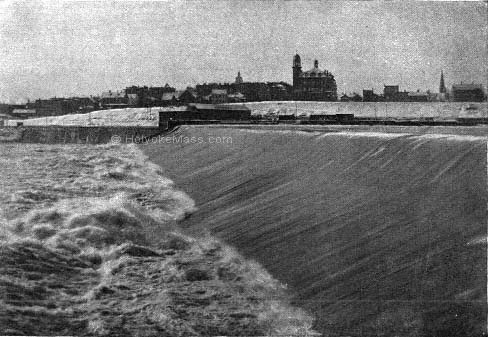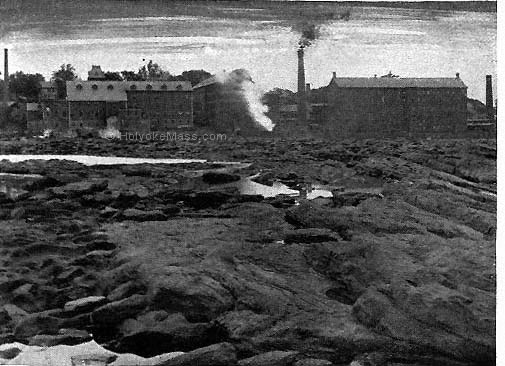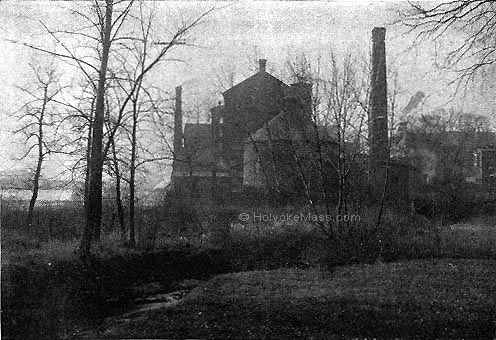South Hadley Falls in 1892
South Hadley Falls has such close connections with Holyoke and Hampden county that it seemed meet to include it in this work, although, geographically, Hampshire has the larger claim on it.
The village is in part included within the boundaries of Chicopee, and it is thus brought partly into Hampden, and the place is so connected by the big bridge and frequently-running electric cars and its business interests in general with Holayoke as to be in reality a suburb of that city.

The Dam, From the South Hadley Falls Shore.
|
The two paper mills and the Glasgow gingham mill, by the riverside at the dam, are its chief source of life, but it as well shelters in its homes a great number who gain a livlihood in Holyoke’s mills and shops. A variety of small stores cluster at the bridge entrance and dot the main street up to the mills. At the end of the street is the famous old brick tavern of boating and stagecoach days, and close by are the Congregational and Methodist churches, and the engine house with its bell tower. A steep hill rises here northerly, and the streets mounting it, with the dwellings and outbuildings perched among them, have a peculiar quaintness and interest. Some of the structures are quite ancient, and one or two groups of old willows send up their straggling trunks to add to the old-world attraction of the place. The new is silent and noncommittal.

The River Bed Below the Dam.
|
Age gathers about itself mystery, and we know that every old building has the lives of many people interwoven with the gathering grayness of its years, and that it has many stories to tell. From the hilltop, which shows signs of an intermittent quarrying being carried on, one can look straight down on the village roof-tops, and only the church spires lift themselves above the horizon line. Close by here is a big, grim building of brick, known as the Glasgow block. Its tall massive form, with its heavy chimneys and stepped gables, give it a strong individuality. From here it is easy to descend a long flight of stairs, from the Carew office on the hill, to the bridge crossing the canal below, and then following up the level a little, visit the dam. It is an interesting place on the heavy stone bulkhead. Above is a broad sweep of quiet river, with low hill ranges beyond, and, in the north, a glimpse of the mountains; close at hand is the east bank lined with bushes and trees; across the stream Holyoke’s multitude of buildings with their chimneys and spires, and prominent among them the square-towered city hall; but the dam is chief feature of the surroundings. The water falls over its crest in a smooth curve that, gaining in swiftness as it slips down the long incline, roughens, and whitens, and at the end plunges into the mass of boiling foam below, and is lost in fierce commotion. It the wind lows, the air is filled with driving spray, and you may catch tints of rainbows in the mists if the sun is right. The falling water fills the air with a solemn, loss-tossed roar, that is yet so loud one wonders what it was like in its thunder in the fabled days before the apron was added.

South Hadley Falls: A View of the Mills.
|
Along the bank here, on a gradual slant from the level of the water above the dam to that below, is a curious network of timbers, through which a little stream keeps up a dodging, tortuous course, with much the same difficulty in finding its way that one has in working to the goal in one of the labyrinth puzzles you find in children’s magazines. This is a fish-way, intended for such shad as have enterprising intentions of going up stream. One would naturally suppose the passage better fitted for eels than any other of the finny tribe, as these sudden turns and so many of them would be calculated to break the back of an ordinary fish before it had gone far. Retracing our steps along the swift, smooth-running canal, and climbing the stairs up the rocky face of the cliff, we follow High street, and at the end we come to the Catholic church on its terrace, overlooking the neighborhood about, and then, continuing a little westerly, we find lamb’s grove. There was a time when this was a favorite picnic resort, and, in its way, there is still no prettier spot in the region. The wood is well grown, and the oaks and chestnuts, with their smooth-shafted trunks, are quite handsome. Here and there a hemlock, with its evergreen foliage, adds variety. The earth beneath is a grassy carpet, free from brush, and a scattering of mossy hummocks furnishes first-rate seats. The land slopes gently away to the river whose shining strand divides the western landscape, and a little southerly you catch the smoke-dimmed outlines of Holyoke.
© Laurel O’Donnell 1996 - 2006, all rights reserved
This document may be downloaded for personal non-commercial use only
and may not be reproduced or distributed without permission in any format.
This is an edited adaptation from the original publication.
|